The Bloomington Metro Story: Told by STATS Indiana
This article, the fourth in a series about Indiana's metro areas, will focus on the Bloomington metro. All data used for this article are available via the USA Counties and Metros Side-by-Side profiles on STATS Indiana (www.stats.indiana.edu).
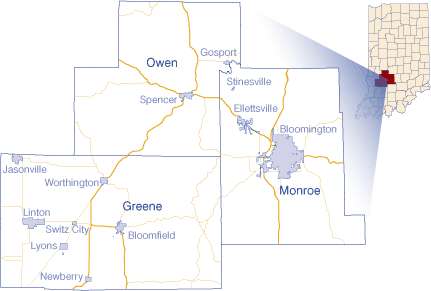
The Area
Three counties make up the Bloomington metro: Greene, Monroe and Owen. In 2006, these three counties contained slightly more than 178,700 residents, a 14.1 percent increase since 1990. That growth rate was faster than Indiana overall (13.9 percent growth) but lagged the national rate of 20.3 percent. Taking an even longer view, the Bloomington metro has seen an increase of 43.8 percent since 1970, whereas the state has grown 21.5 percent and the nation has grown 47.3 percent.
The median age of residents in the metro (31.4) is lower than in Indiana (36.3) and the United States (36.4). This is due to the presence of Indiana University Bloomington drawing younger adults to the area. This is also reinforced by the population by age data (see Figure 1). One in every five people is college-age in the Bloomington metro, compared to less than one in 10 people at the state and national levels.
Figure 1: Age Distribution as a Percent of Total Population, 2006
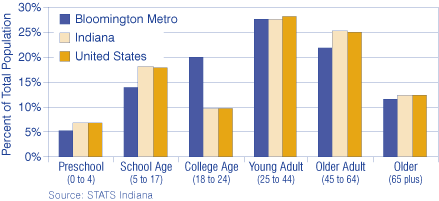
Jobs & Wages
Jobs in the Bloomington metro have risen over the past 10 years, posting a gain of 6.9 percent. This is a faster rate of growth than Indiana overall (5.3 percent) but about half the growth rate of the nation (13.6 percent).
Manufacturing, retail trade, health care and social assistance, and accommodation and food services each contributed more than 10 percent of total private jobs in the Bloomington metro (see Figure 2). Accommodation and food services was not as prevalent in the state and nation as it was in the metro.
Figure 2: Jobs as a Percent of Total Private Employment, 2006
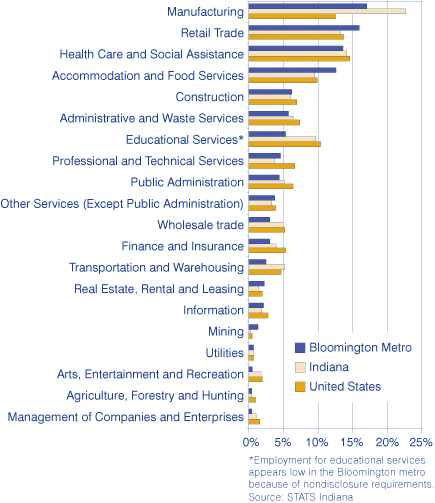
Wages in the Bloomington metro and Indiana as a whole didn't quite stack up to wages in the United States. Figure 3 shows that only management of companies and enterprises in the metro paid more than the U.S. level and only agriculture, forestry, fishing and hunting paid more than the U.S. level for the state. Over the past decade (1996 to 2006), the Bloomington metro's average wages per job have paralleled those of Indiana's, albeit lower. Unfortunately for both the state and the metro, these wages have been shrinking as a percent of U.S. wages (see Figure 4). It is important to keep in mind, however, that the area's student influence (in other words, lots of part-time workers) has a tendency to negatively skew wage data in metros with large universities.
Figure 3: Wages in the Bloomington Metro and Indiana as a Percent of U.S. Wages, 2006
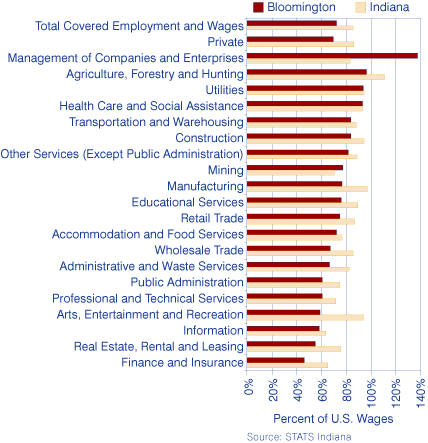
Figure 4: Wages in Peer Metros and Indiana as a Percent of U.S. Wages, 1996 to 2006
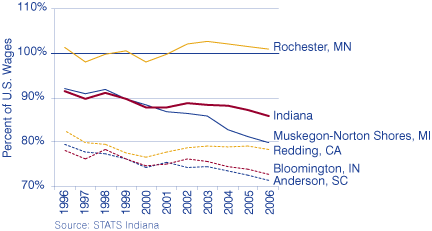
Population Peers
To put the data more in perspective, let's find some of the Bloomington metro's peers in population. Other metros with similar population numbers (between 175,000 and 180,000) and universities include:
- Redding, Calif., (179,951 people) is home to Shasta College, National University and Simpson University.
- Rochester, Minn.,(179,573 people) is home to the University of Minnesota, Saint Mary's University of Minnesota and Augsburg College
- Anderson, S.C., (177,963 people) is home to Anderson University and Tri County Technical College
- Muskegon-Norton Shores, Mich., (175,231) is home to Grand Valley State University and Muskegon Community College
The Bloomington metro's trend in wages is most similar to Anderson, S.C. (see Figure 4).
In almost all cases among the Bloomington metro and its peers, manufacturing, retail trade and health care and social assistance were among the top three industries for jobs as a percent of total private jobs (as was the case in Indiana and the United States as well). The exception was Redding, Calif., where manufacturing ranked eighth among the 20 industry sectors. The industry distribution of jobs in Anderson, S.C., were similar to those in the Bloomington metro.
Conclusion
Compared to the state and nation, the Bloomington metro's jobs and wages may not be shed in the best light. However, looking at other similar metros across the United States, we find that the student presence in these metros influences various aspects of the metro economy. In the Bloomington metro, specifically, the population is younger, there is a high concentration of workers in accommodation and food services, and reported wages are lower than the state and national levels. In other words, compared to geographic areas with similar characteristics, the Bloomington metro appears to be on par.
Molly Manns, Associate Editor
Indiana Business Research Center, Kelley School of Business, Indiana University
